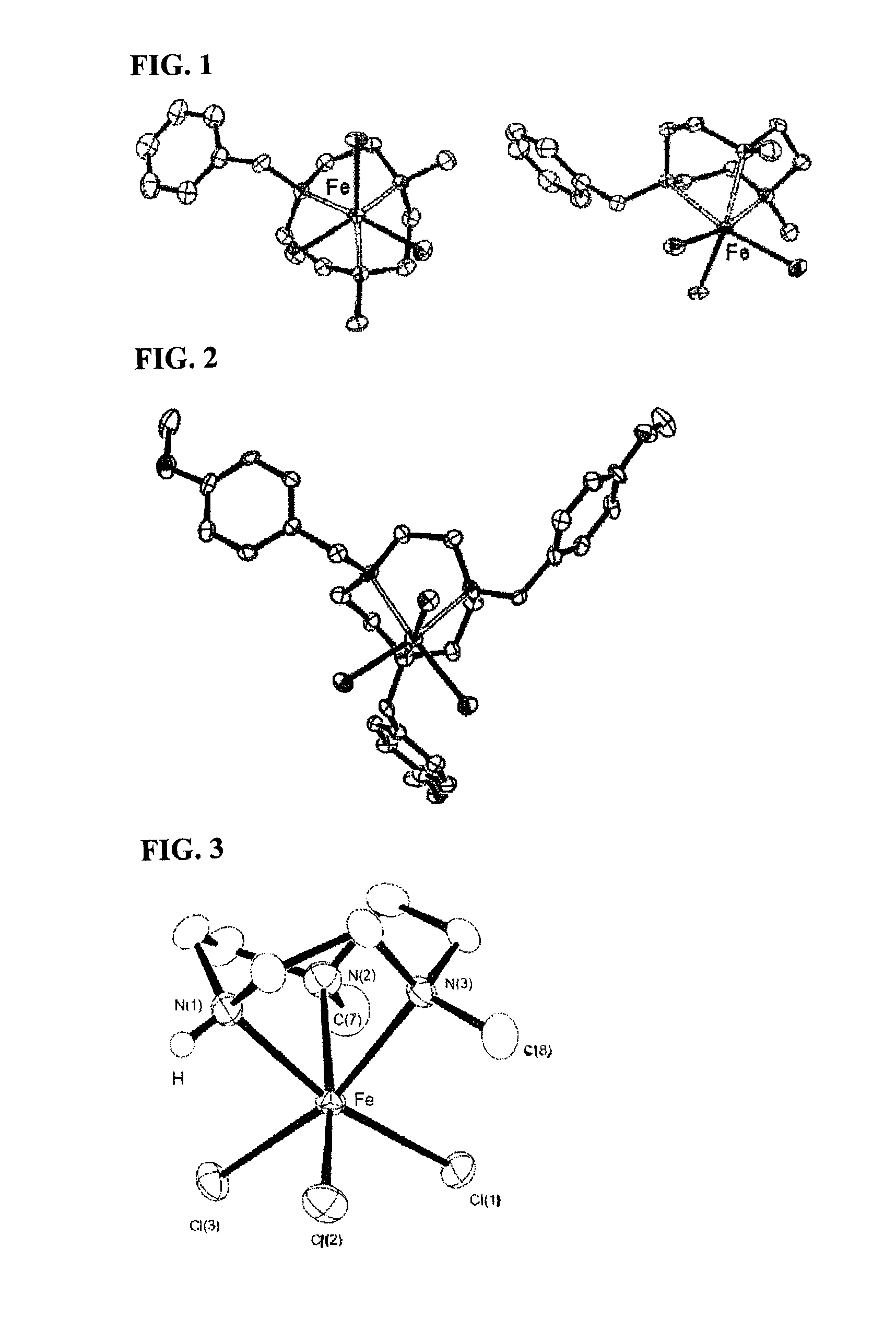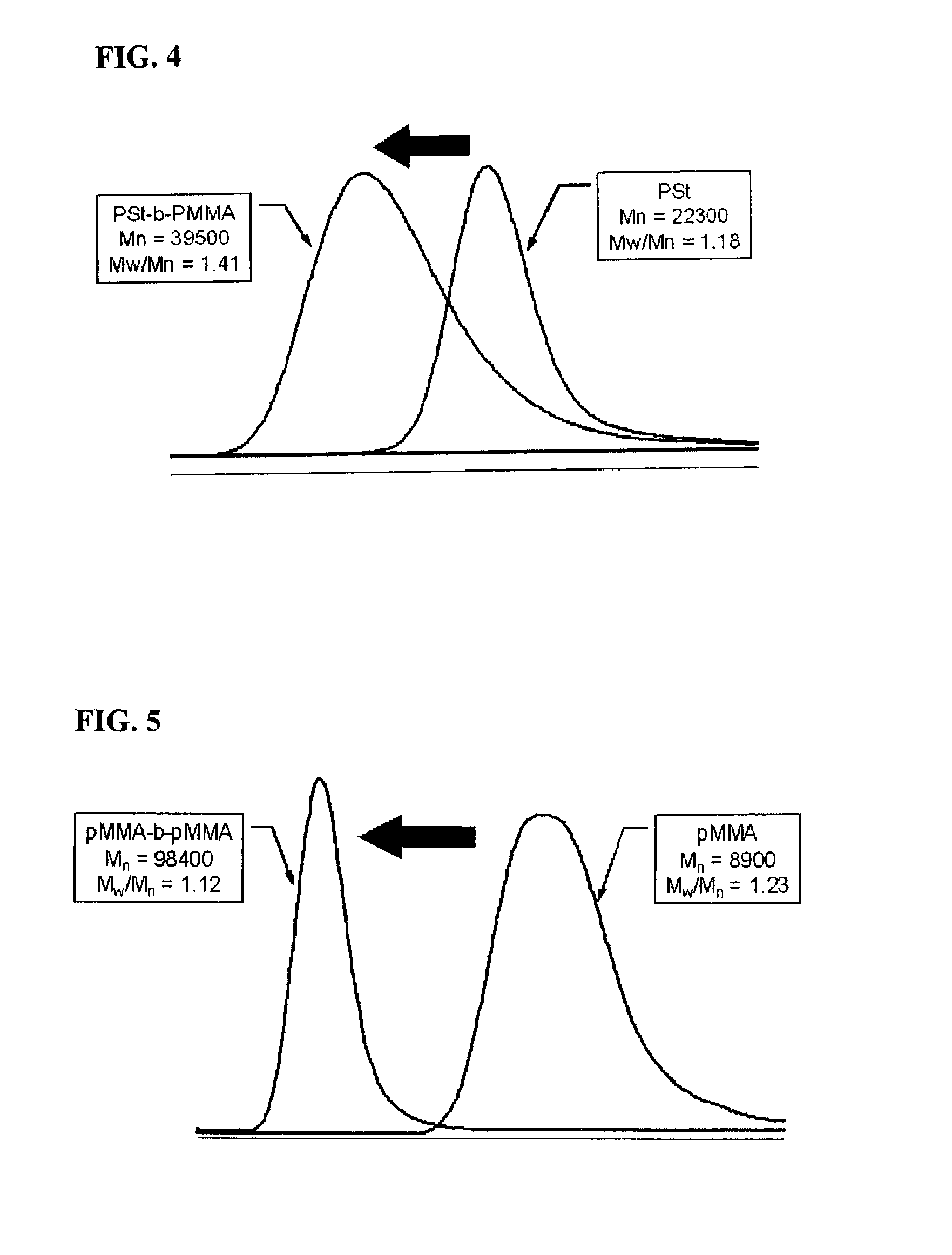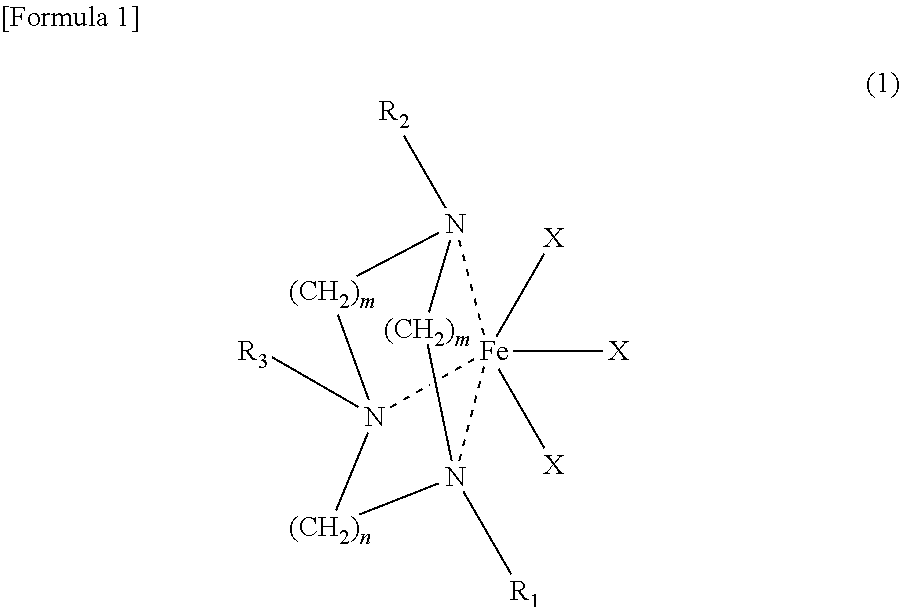Process for production of polymers with iron complex catalyst
a polymer complex and catalyst technology, applied in the field of iron complexes, can solve the problems of metal not showing catalytic activity, metal catalytic efficiency reduction, increase the concentration of metal, etc., and achieve the effect of superior iron complex catalytic activity, simple production, and simplified post-processing process
- Summary
- Abstract
- Description
- Claims
- Application Information
AI Technical Summary
Benefits of technology
Problems solved by technology
Method used
Image
Examples
example 1
Synthesis of Iron Complex 1
[0072]178 mg (1.1 mmol) of anhydrous FeCl3 and 40 mL of anhydrous diethyl ether were added to a 100 mL Schrenck tube in an argon atmosphere. After they were completely dissolved, a 10 mL anhydrous diethyl ether solution of 247 mg (1.0 mmol) of 1-benzyl-4,7-dimethyl-1,4,7-triazacyclononane synthesized according to the method described on p. 189 of Inorganica Chimica Acta Vol. 295, 1999, was dripped in slowly at room temperature. After mixing for one hour, a crude product containing complex 1 was separated out by filtration. After this solid was heated and dissolved in 50 mL of acetonitrile and the undissolved material eliminated by filtration, the filtrate was concentrated, and a bright yellow iron complex 1 (Formula 3) was obtained (Yield: 323 mg, 94%). The structure of the complex was confirmed using single crystal x-ray structure analysis. It is shown in FIG. 1.
example 2
Synthesis of Iron Complex 2
[0073]422 mg (2.6 mmol) of anhydrous FeCl3 and 80 mL of anhydrous diethyl ether were added to a 100 mL Schrenck tube in an argon atmosphere. After they were completely dissolved, a 15 mL anhydrous diethyl ether solution of 978 mg (2.0 mmol) of 1,4,7-tris(4-methoxybenzyl)-1,4,7-triazacyclononane synthesized according to the method described on p. 11575 of the Journal of the American Chemical Society Vol. 118, 1996, was dripped in slowly at room temperature. After mixing for one hour, a crude product containing complex 2 was separated out by filtration. After this solid was dissolved in 130 mL of methylene chloride and the undissolved material eliminated by filtration, the filtrate was concentrated, and a bright yellow iron complex 2 (Formula 4) was obtained. (Yield: 1.22 g, 94%). The structure of the complex was confirmed using single crystal x-ray structure analysis. It is shown in FIG. 2.
example 3
Synthesis of Iron Complex 3
[0074]162 mg (1.0 mmol) of anhydrous FeCl3 and 40 mL of anhydrous diethyl ether were added to a 100 mL Schrenck tube in an argon atmosphere. After they were completely dissolved, a 10 mL anhydrous diethyl ether solution of 533 mg (1.33 mmol) of 1,4,7-tribenzyl-1,4,7-triazacyclononane synthesized according to the method described on p. 491 of Organometallics Vol. 15, 1996, was dripped in slowly at room temperature. After mixing for one hour, a crude product containing complex 3 was separated out by filtration. After this solid was dissolved in 100 mL of methylene chloride and the undissolved material eliminated by filtration, the filtrate was concentrated, and a yellow iron complex 3 (Formula 5) was obtained (Yield: 533 mg, 95%).
[0075]The results of using FeCl3.6H2O instead of FeCl3 are shown in the following comparative example.
PUM
 Login to View More
Login to View More Abstract
Description
Claims
Application Information
 Login to View More
Login to View More - R&D
- Intellectual Property
- Life Sciences
- Materials
- Tech Scout
- Unparalleled Data Quality
- Higher Quality Content
- 60% Fewer Hallucinations
Browse by: Latest US Patents, China's latest patents, Technical Efficacy Thesaurus, Application Domain, Technology Topic, Popular Technical Reports.
© 2025 PatSnap. All rights reserved.Legal|Privacy policy|Modern Slavery Act Transparency Statement|Sitemap|About US| Contact US: help@patsnap.com



